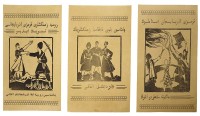Agitprop (Agitation and Propaganda Department)
1920 to 1928
The task of disseminating political information fell to the Agitation and Propaganda Department (Agitprop) of the Communist Party’s Central Committee. Agitprop was formed in 1920 and it was placed under Glavpolitprosvet (Main Department for Political Education). Early-on, the term Agitprop described a politically-themed theatrical performance, but over time, the term later described a variety of art developed for political education. Agitprop relied on artists working as a collective in addition to working under the notion that social change would be achieved through artistic expression. Agitprop work covered live performance to graphic design, to the decoration of boats and trains. In 1928, it merged with the Press Department of the Central Committee to create the Department of Agitation, Propaganda and Press. As an artistic movement, Agitprop quickly faded by the 1930s when Socialist Realism emerged as the leading art form in the Soviet Union.
Fuentes
Kiianskaia, O.I., & Fel’dman, D.M. (2018). Slovesnost’ na Doprose: Sledstvennye dela sovetskikh zhurnalistov I pisateli 1920-1930-x godov. Moskva: Forum, Neolit. (p. 348, Agitprop years 1920-1928)
Chilvers, I., & Glaves-Smith, J. (2009) Oxford Dictionary of Modern and Contemporary Art: 2nd Edition. Oxford: Oxford University Press. (p.14, agitprop bio)
Kenez, P. (1985). The birth of the propaganda state: Soviet methods of mass mobilization, 1917-1929. Cambridge: Cambridge University Press. (p. 124, coordination of Agitprop sections)
britannica.com (Agitprop, defined)
Fitzpatrick, S. (1970). The commissariat of enlightenment: Soviet organization of education and the arts under Lunacharski. Cambridge: Cambridge University Press. (p. 181, Agitprop under Glavpolitprosvet)
